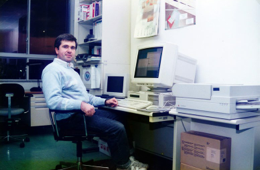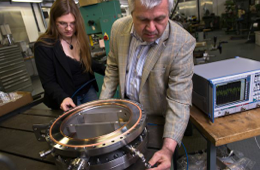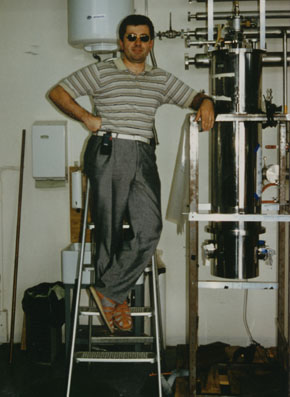About Me
I was born in a small village in southern Germany (Eschenau, state Baden-Württemberg) and studied physics at the University of Stuttgart, which has a strong focus on solid state physics. When choosing the subject for my Master’s Thesis in 1985 I was attracted to the field of nuclear methods in solid state physics, joining the Max Planck Institute for Metals Research in Stuttgart on a project using positive pions as light isotopes of hydrogen in metals, studying their diffusion behavior. The experiments were carried out at Paul-Scherrer-Institute (PSI) in Villigen, Switzerland (at that time still called Swiss Institute for Nuclear Research, SIN).
The intense work at an international accelerator facility in a small group immediately fascinated me and I stayed with these surroundings for the rest of my career. For my Ph.D. thesis I used a small electrostatic accelerator (a pelletron) just being finished at MPI Stuttgart having a MeV positron beam to search for resonances in electron-positron scattering as a possible explanation for correlated electron-positron pairs seen in heavy ion collisions at GSI Darmstadt. Observing no resonances, this experiment was the first to show that the results of the GSI experiments were just statistical fluctuations.


For a postdoc I went to Japan to the Institute for Nuclear Studies of the University of Tokyo in Tanashi in 1990, my host being its director, Toshi Yamazaki. In an experiment E215 at KEK we found anomalously long-lived states of antiprotonc helium, an exotic three-body system consisting of a helium nucelaus, an electron and an antiproton. The study of this exotic atoms has now spanned 20 years, first at LEAR of CERN (where I spent three years as a CERN fellow in 1993-1997) and then within the ASACUSA collaboration at the Antiproton Decelerator (AD) of CERN.
After the CERN fellowship I spend one year at the Meson Science Labortory of Ken Nagamine at RIKEN working on the creation of an ultra-slow beam of positive muons from the laser ionization of muonium. After the approval of the AD at CERN and a large grant in Japan I moved in 1998 to the group of Ryogo S. Hayano at the Physics Department of the University of Tokyo in charge of setting up the infrastructure of the new ASACUSA area at CERN. I continued the laser and microwave spectroscopy of antiprotonic helium, and together with Toshi Yamazaki created a proposal to measure the hyperfine structure of antihydrogen as one of the most sensitive tests of CPT Symmetry.in 2004 I moved to Vienna to become the director of the Stefan Meyer Institute for subatomic physics which had a strong background in strong interaction studies using exotic pionic and kaonic atoms. I added this topic to my field of interest and am now expanding into the field of hadron spectroscopy at BELLE and in the future with PANDA at FAIR.
From 2004 I was actively promoting the FLAIR facility as a next generation facility for low-energy antiproton physics at FAIR at Darmstadt. Due to financial shortcomings FLAIR is now postponed into a later stage of FAIR, but CERN has approved an extension to the AD called ELENA so that low-energy antiproton physics continues to have a bright future. In 2011 I received an Advanced Investigator Grant of the European Research Council for my project on measuring the hyperfine structure of antihydrogen.





Ph. D. hat, Stuttgart 1990

CERN, Geneva 1994
